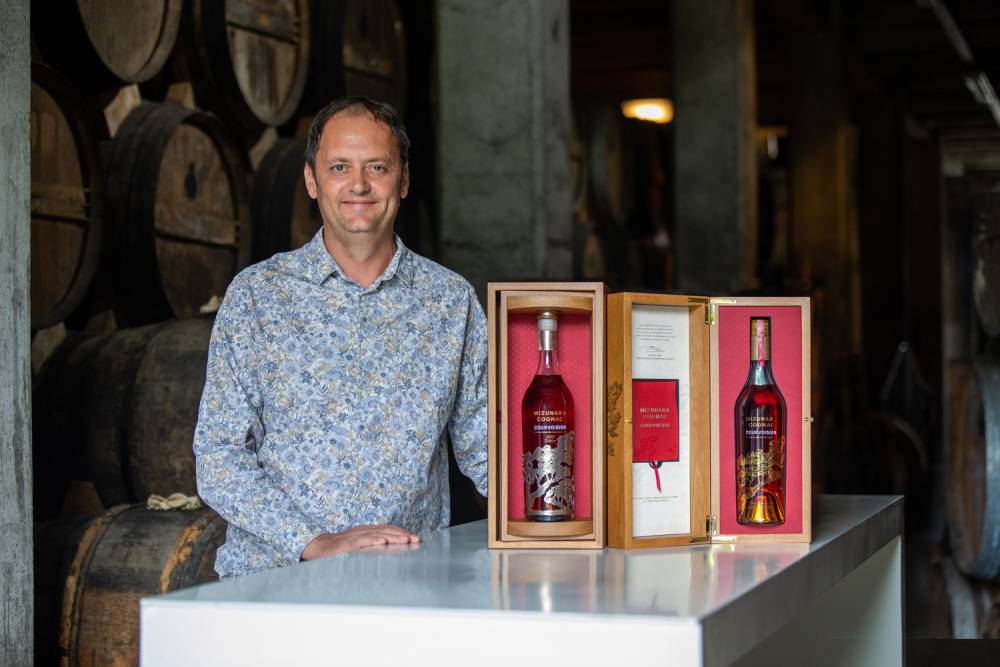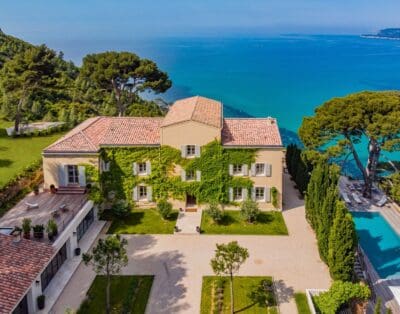Courvoisier’s 2023 Mizunara – A True Masterpiece
The realm of alcoholic spirits offers an array of delightful flavours to be savoured, experienced, and enjoyed. On rare occasions, a single spirit can evoke sheer, unfiltered joy, akin to the elation of an 8-year-old at a Disney theme park. While I refrained from bouncing up and down with excitement (out of respect for my fellow writers during our visit to Courvoisier to taste their new 2023 Mizunara Cognac), a beaming smile remained plastered on my face long after I had finished tasting.
This remarkable spirit introduced flavours previously unencountered and unexpected in a Cognac, in a very positive way. I could easily exhaust superlatives such as brilliant, astonishing, finessed, balanced, extraordinary, sublime, and exquisite in describing it – it was that good. If I didn’t want you to read this entire feature I would be recommending you secure a bottle yourself, if still available, from Harrods, Selfridges or Harvey Nichols, priced at £2500 right now, before they are all sold out.
This 2023 Courvoisier Mizunara (only 500 bottles available globally) is a collaboration between Maison Courvoisier’s Seventh Chief Blender, Thibaut Hontanx, and the House of Suntory’s Fifth Generation Chief Blender, Shinji Fukuyo. It has been meticulously crafted from eau-de-vie sourced from the finest crus of Grande Champagne, Petite Champagne, and Borderies, resulting in a multi-layered, complex flavour profile.
If you are among the fortunate few to secure a bottle, you are in for an extraordinary treat. This Cognac deserves to be savoured and shared with friends, preferably accompanied by Courvoisier XO and XO Royale to explore the Mizunara’s unique influence. Whilst gathered around taking in the finer nuances that develop in the glass over time, study the bottle design to seek out an artful depiction of Japan and France shown within the golden Mizunara tree.
Before delving into the flavours of the 2023 Courvoisier Mizunara, it is essential to provide a brief background to appreciate the significance of this release.
Cognac is situated in southwestern France and nestled along the 224-mile-long Charente River that originates near Chéronnac in the Limousin region and meanders its way through the countryside, eventually emptying into the Bay of Biscay near the town of Rochefort. Should you follow the river you will encounter a diverse landscape of rolling vineyards, historic towns and villages along its banks. It is known for its picturesque beauty and attracts tourists and nature enthusiasts keen to take in the tranquil surroundings. Its roots in spirit production trace back to the 16th century when Dutch merchants pioneered the distillation of wine in the region for easier transportation and preservation.
Evolving over time, Cognac became a sought-after spirit across Europe, leading to the establishment of official regulations in the 19th century to safeguard its authenticity and quality. Félix Courvoisier founded Maison Courvoisier in 1828 in the charming town of Jarnac, utilising the Charantes River for transporting barrels to the coast for export. Today, the vast majority of Cognac is exported, with the main consumers being the USA.
The Cognac region enjoys a temperate oceanic climate, with mild winters and warm summers, providing ideal conditions for grape growing. The land primarily comprises fertile limestone and chalk soils, imparting distinct characteristics to the grapes. The soils typically have good drainage and retain essential nutrients like calcium, magnesium, and potassium, which are crucial for the healthy growth and development of the vines. They absorb heat during the day and release it slowly at night, helping to maintain more stable soil and air temperatures.
The grapes, mostly Ugni Blanc (also known as Trebbiano in Italy), but may include Folle Blanche, Montils, Sémillon and Colombard, undergo fermentation after harvest in late September to early October, yielding a wine relatively low in alcohol. This wine then undergoes a double distillation in copper pot stills, resulting in the eau-de-vie, which is aged for a minimum of two years in oak barrels.
Notably, individual Cognac houses produce different eau-de-vies based on various factors, including grape variety, ripeness, the shape of the still, fermentation length, and distillation time. Courvoisier is renowned for its eau-de-vie featuring fruity and floral notes such as jasmine, accompanied by hints of dried fruits like apricot, peach, and raisins.
The oak maturation process significantly influences flavour, and Courvoisier’s approach involves using a combination of fine and large grain staves in each barrel, sourced from 100-150-year-old trees and seasoned outside at their facility to “season”. During this time the individual staves shrink in depth by around 5mm from 32mm to 27mm. Enough stock is held to make 6000 barrels (around 3 years worth) with 35 staves going into each barrel. Sustainability is at the forefront, with a solid re-planting program in place.
The exceptional nature of Courvoisier’s Mizunara stems from its 10-year maturation in regular oak barrels before a carefully selected and small amount (mostly from Grande Champagne) is transferred into Mizunara barrels for a further maturation period. In this, the second release, that time was 40 months. This is not a “finishing” process, but an ageing one that cannot be rushed. In fact, it is forbidden to use the term “finish” in Cognac and only brand-new barrels, or those that have previously contained wines may be used by law.
Thibaut explained that after 6 months in Mizunara casks the Cognac is disappointing – the anticipated characteristics yet to develop. This is to be expected, Patrice Pinet (Thibaut’s predecessor) had experienced the same and was advised by Shinji to be patient and allow the spirit and wood time to intertwine and develop their relationship until it blossomed.
Interestingly. Jarnac was the childhood home of former French President Francois Mitterand who had a saying that was widely adopted across France “Laisser le temps autemps”. Translated this roughly means “let time do its work”, and this is very much true when working with Mizunara.
Also known as Japanese oak, Mizunara is a unique type of oak tree native to Japan and renowned for its extraordinary aromatic properties, which set it apart from other oak species. The wood imparts a delicate and complex bouquet with common aromas including sandalwood, coconut, vanilla, incense, and a spicy fragrance reminiscent of cloves and cinnamon.
It possesses a unique cellular structure that makes it highly porous compared to other oak species commonly used in barrel-making, such as American or European oak. While this porosity enhances the wood’s interaction with the spirit during ageing, it also makes Mizunara oak more fragile and prone to cracking during the coopering process. This is what makes it rather rare as it is notoriously hard to work with. The tree adds further challenges by not growing straight and with a high concentration of knots. It is also prone to leaking, not ideal when a barrel contains your finest cognacs.
Couple this with the oak’s exceptionally slow growth, taking several centuries to reach maturity, the supply of mizunara wood for barrel-making is very limited and highly sought after. In fact, only 200 barrels are made every year in total, with these being primarily used in whisky making. It is this that makes the Courvoisier Mizunara so special, very unique, rare and a privilege to taste.
Contrary to what you might imagine, Courvoisier does not use its oldest Cognac stocks for this special release; instead, it builds upon its stocks that would have been destined for its XO, which are a minimum of 10 years old. The art lies in skillfully blending individual Cognacs from various barrels, predicting their harmonious cohesion within the Mizunara cask to create a Cognac that left me spellbound.
The passion involved in creating this assemblage was evident. It transcends from a technical exercise to one of emotion, evoking memories and exploring different sensory paths. For this is the art of blending. The master blenders know each cellar, their humidity levels, and how that affects the barrels, how individual barrels, even laying side by side may give a different flavour profile. They understand what each cru brings and how they work together in the final assemblage:-
Grande Champagne: Often considered the premier cru, cognacs from Grande Champagne are known for their finesse, elegance, and floral aromas. They tend to exhibit flavours of white flowers, citrus fruits, and a long, refined finish.
Petite Champagne: Similar to Grande Champagne, Petite Champagne produces cognacs with floral and fruity characteristics. The flavours may include apricot, plum, and sometimes a slightly spicier or more vibrant profile compared to Grande Champagne.
Borderies: Cognacs from the Borderies Cru typically showcase distinct fruity flavours, including ripe pear, peach, and violet notes. They are known for their roundness and smooth, velvety texture.
As you can imagine, blending is a highly skilled task that requires an exceptional nose, precision and palate, coupled with decades of experience. Thibaut and Shinji were left with no room for error with only two barrels at their disposal, and the weight of the board on their shoulders. Crafting a statement Cognac like this is high pressure but they have totally embraced the challenge. And succeeded.
It was a real privilege to taste not only the 2023 release but also its predecessor, the 2022, in Courvoisiers Louis Renard cellars overlooking the river with Thibaut. The 2023 provided notes of apricots initially, smelling almost like a liqueur. My notes went on to read – reminiscent of an apricot clafouti, coconut, tropical, beautiful spices. Extraordinary really. With time, flavours reminiscent of a rich orange marmalade reducing on the stove with a beautiful and balanced sweetness. A wonderful length with spices including cloves developing on the palate. Truly remarkable and unique.
I was not the only person in the room smiling. Observing my fellow writers, I noted how they too were transfixed by the Mizunara. Previously, one very experienced and respected writer declared the standard XO to be the best he had ever tasted. Quite a statement but one that is understandable given the finesse these Cognacs possess. Being the foundation for the Mizunara, it is no wonder how exceptional it is.
The day prior to visiting the cellars we enjoyed a wonderful lunch in the vineyards at Domaine Guilloteau. The estate was purchased by Courvoisier in 2021 and will be used for distillation and experimentation within the strict parameters set down for Cognac production. I found this to be very encouraging – often Cognac houses, especially when 200 years old, can be slow to change, innovate or do anything adventurous. As a consumer, I embrace change, whilst hoping the past is respected. I seek out different flavours, for that is what the enjoyment of all drinks is about. Courvoisier is clearly doing this. And that makes me jump with joy.







